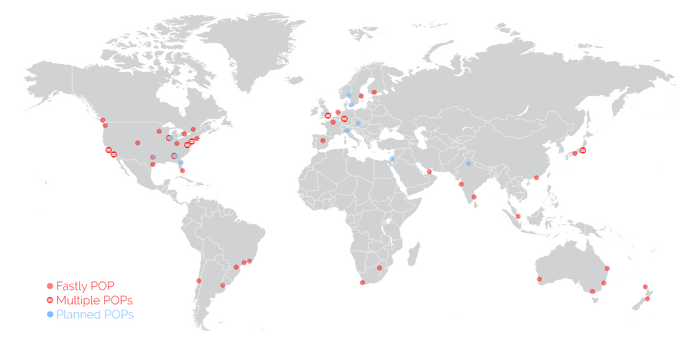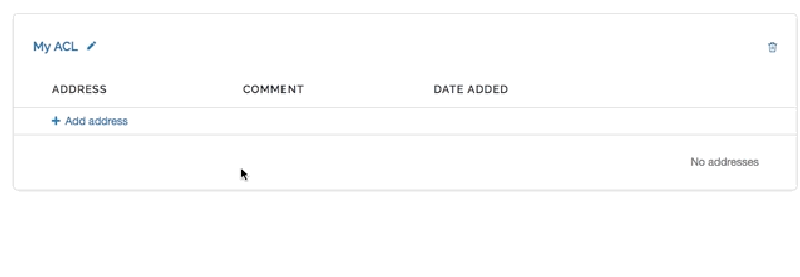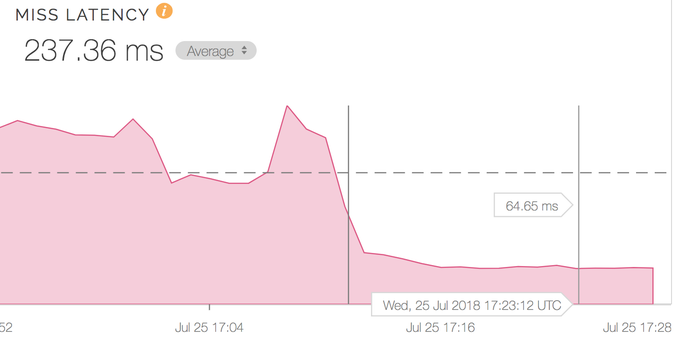Q3 2018
Hi Fastly customers + friends,
In Q3, we added an assortment of new features and increased the size of our network. We introduced functionality to further enhance security at scale, decrease time to first byte for large and encrypted files, add basic effects to images, and more. We also brought our total global number of Fastly POPs to 54, along with 26 Tbps of connected network capacity. Read on to learn what we’ve been up to last quarter.
POP additions and enhancements: 54 global POPs
As of the end of Q3, Fastly now operates 54 POPs worldwide. We made additions and enhancements to POPs across five continents:
North America: doubled capacity in our Chicago (MDW) POP
Europe: deployed a new POP in Helsinki, Finland (HEL)
Asia: deployed a new POP in Tokyo (TYO), our 4th POP in Japan
South America: deployed Curitiba (CWB) as our 3rd POP in Brazil, and doubled capacity in our Buenos Aires (EZE) and Santiago (SCL) POPs
Africa: doubled capacity at our Johannesburg (JNB) POP

Network capacity update: 26 Tbps of edge capacity
New POPs and network growth at existing POPs yield an increase of 3 Tbps of new edge capacity in Q3, bringing our total connected edge capacity to 26 Tbps.
Fastly is now present at 65 Internet Exchange Points (IXPs). We joined the following new IXPs this past quarter:
DET-IX in Chicago (MDW)
NL-IX in Amsterdam (AMS) and Frankfurt (HHN)
APE in Auckland (AKL)
WIX in Wellington (WLG)
Internet service providers (ISPs), enterprises, and cloud service providers (CSPs) can interconnect with Fastly directly at these IXPs to reduce network hops over the internet (see https://www.fastly.com/peering for more information). This enables low latency and highly performant connections to Fastly’s edge cloud.
Improvements to the All Services page
We're happy to announce a number of changes to the All Services page. Many of you already use the All Services dashboard as a high-level overview of your Fastly service, and these new features will enhance that experience.
Service version comments: You now have the ability to add notes, comments, or commit messages to a service's version at the time of activation via the Control Panel or API ㅡ with up to 512 characters of text. Version comments are accessible on the service summary page, as well as the configuration page.
Star services: The ability to star specific services allows you to easily access a subset of your entire service portfolio. Starred services will load at the top of the All Services index page, in order of highest traffic. Users control their own stars on a per-account basis, so everyone can build their ideal workflow. We've also shipped load time improvements for the services list in the All Services page.
Condensed service view: For customers with a large number of Fastly services, our default view of five services may not give users the holistic view of their traffic they need. Our new condensed view toggle allows you to increase the number of services you’re monitoring on the All Services page.
UI for Access Control Lists (ACLs)
ACLs, previously an API-only feature, allow you to store a list of permissions that Varnish will use to grant or restrict access to URLs within a service. With these ACLs, you can build allow lists and block lists leveraging the flexibility of Fastly to strengthen your security at the edge. You can now use our new web interface to add, remove, and update ACLs in real time from the Control Panel. For those of you leveraging ACLs in your automated tooling, you can still use the API.

TLS private key and certificate rotation tool in Limited Availability
For customers that manage their own TLS certificates, we released a new UI for certificate renewals and the rotation of private keys. This page allows you to upload your own private keys via a drag-and-drop interface and perform a certificate rotation, provided that the new certificate is an exact match in terms of the included domains (SAN entries). The UI also notifies you of TLS certificates that we recommend updating.
Platform TLS in Limited Availability
Our new Platform TLS product gives companies that offer mass hosting or support multi-brand portfolios the ability to fully automate TLS provisioning at scale — including certificate and key management — through Fastly’s API. Platform TLS supports the delivery and management of hundreds of thousands of certificates, supported by an automated worldwide TLS termination and acceleration solution. This solution ensures a performant, efficient, and consistent approach to TLS management at scale.
The Platform TLS API, which is in Limited Availability, has been updated to include key management, error handling, search, sorting, and greater consistency with the rest of Fastly’s APIs.
New TLS management permission
A new user permission has been added that grants access to modify and manage the account-wide TLS settings. A Superuser can grant this permission to users of any role (User, Billing, or Engineer) via the user access controls UI or via API.
Subscriber Provided Prefix in Limited Availability
Fastly’s Subscriber Provided Prefix is a new service released in Limited Availability for customers who want to remain in control of their IP address space for the long-term. Whether you need to maintain your IP reputation for outbound mail services, or potentially have to use specific addresses for compliance reasons, this service allows you to “whitelist” your address space and future-proof your customers’ brands, while taking advantage of the capacity and ongoing growth of Fastly’s network.
With this service, you provide your own IP address space to Fastly rather than use Fastly IP addresses. In this case, Fastly announces, routes, and serves your IP space via Fastly infrastructure for use with your production services. You can direct traffic to your own IP addresses, which are reachable via HTTP anycast on Fastly’s infrastructure. This service can also be used in conjunction with origin peering and the Fastly DDoS protection and mitigation service to help protect you by being shielded by Fastly’s global network.
Streaming miss with TLS in Limited Availability
We are excited to share that streaming miss with TLS support is now in Limited Availability. Streaming miss is a powerful feature that is helpful to any customer serving files of a few MB in size. With this feature, we can start passing chunks of a large file to the end user as we pull it from origin on a cache miss. This streaming-like delivery dramatically decreases time to first byte on miss and improves your customer experience — but historically, it had the limitation of not being able to use encryption when we connect to origin. This meant that Fastly customers with compliance and security mandates for encrypted data in flight couldn’t use it. This restriction is being removed and anyone wishing to use the feature in Limited Availability can get it enabled by submitting a support ticket.

Basic image effects added to Image Optimizer
Fastly’s image optimizer has added the five basic Image Effect features below. You can now change the brightness, contrast, and saturation of an image, as well as sharpen and blur. Many transformations can be combined to create the desired output for a single image.
Brightness: increases or decreases the amount of perceived light an image radiates
Contrast: increases or decreases the difference between the darkest and lightest tones
Saturation: increases or decreases the intensity of the colors in an image
Sharpen: increases the definition of the edges of objects in an image
Blur: decreases the definition and focus of an image

VCL language reference visual revamp
We recently completed a visual revamp of our VCL language reference, making it easier for you to find the information you need. All VCL reference information now lives in a dedicated space at https://docs.fastly.com/vcl. All changes to our documentation can be tracked in our documentation changelog. If you’re curious about the VCL-specific changes, look for the section titled “New and recently updated VCL docs.”